Education and Research opportunities at UniBo
The University of Bologna stands as a flagship of excellence in Paleontology.
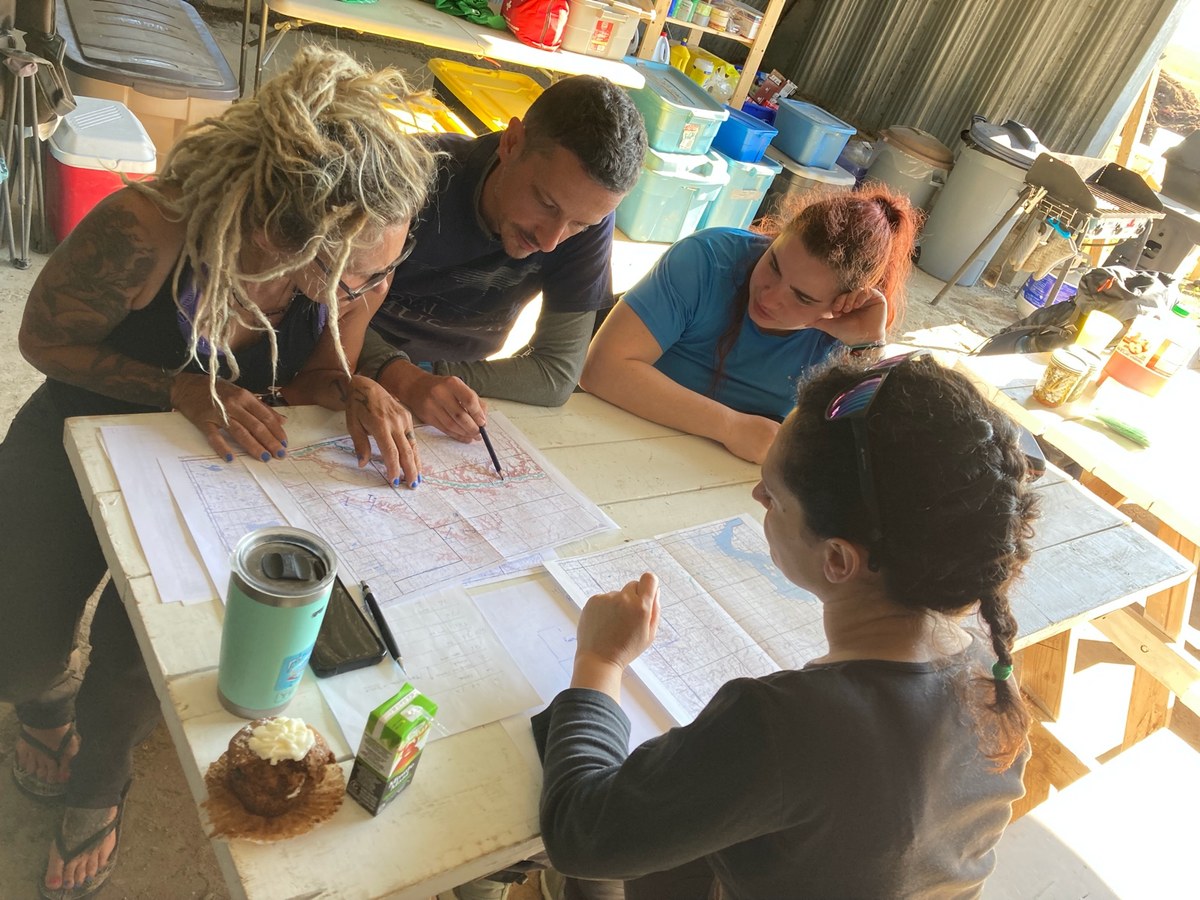
Nowadays, students can benefit from both Bachelor and Master degree programs provided by the Department of Biological, Geological and Environmental Sciences (BiGeA)
In particular, classes coordinated by Prof. Fanti are part of the curriculum of the Bachelor in Geological Sciences, Master in Biodiversity and Evolution, and Master in Teaching and Communication of Natural Sciences.
Courses by prof. Fanti are:
Paleontology (Module 1) First cycle degree programme (L) in Geological Sciences
Paleobiology Second cycle degree programme (LM) in Biodiversity and Evolution
Vertebrate Paleontology Second cycle degree programme (LM) in Biodiversity and Evolution
Research projects
Our research projects offer opportunities for undergraduate, master, and Ph.D. thesis projects. Check out here the projects that we have developed with our students.
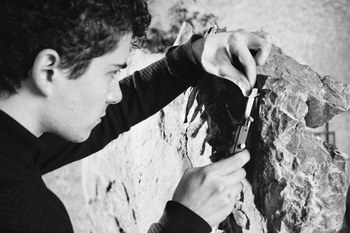
Marco Muscioni - PhD candidate
Review and in-depth analysis of the paleobiota from the lagerstätte Villaggio del Pescatore (Duino-Aurisina, Trieste), with a specific focus on archosaurs. Thanks to the collaboration with Elettra Sincrotrone (Basovizza, Trieste) the project integrates macroanatomical and microtomographic approaches, as well as the paleoenvironmental and paleobiogeographic contextualization of the taxa under study. The objective is to provide the most complete palaeoecological picture of the adriatic carbonate platform from the Campanian (Cretaceous).
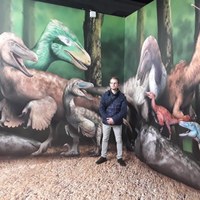
Marco Gottardo - LM Biodiversity and Evolution
Reconstructing the soft tissues of extinct organisms is a key line of evidence for interpreting their paleobiology. Abundant cranial and postcranial remains of the theropod dinosaur Allosaurus were retrieved from the Late Jurassic fossil site of Andrés, Portugal, during field seasons between 1998 and 2010, providing enough material to attempt a reconstruction of the jaw adductor muscles in this taxon. The goal of the project is to employ the open-source 3D modeling software Blender to digitally restore the cranial bones of Allosaurus, mount them into a complete skull, and reconstruct the jaw-closing musculature. Based on these results, the bite force of the organism was estimated and compared with previous analogous studies, therefore confirming the effectiveness and reliability of Blender in the wider context of virtual paleontology.
In cooperation with Universidade de Lisboa (co-supervisor: Elisabete Malafaia).
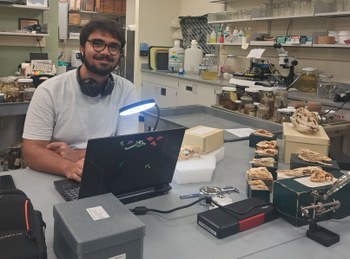
Giacomo Gobbo – Master’s Degree in Biodiversity and Evolution
Research project aimed at studying and reconstructing the perioral tissues of Camarasaurus and the sauropod dinosaurs, through quantitative and qualitative analysis of the facial foramina and the cranial rostral neurovascularization. During its execution, data on the foramina and the surface morphology of the skulls of several fossil and modern reptile specimens were examined and sampled from the collections of the Sauriermuseum in Aathal and the Field Museum of Natural History in Chicago (USA). Conducted in collaboration with the Sauriermuseum in Aathal (Zurich, Switzerland) and the University of Zurich (UZH) (Dr. Dennis Hansen). (Co-supervisor: Dr. Simone Maganuco)
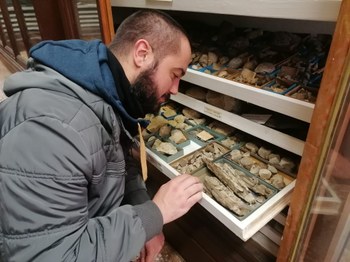
Marco Tersigni - Laurea Magistrale in Scienze e Gestione della Natura
The paleontological collections at the Capellini includes rare and well preserved fossilized Miocene odontocetes. This project aims to provide a full revision of all material assigned to this group and quarried in Veneto as well as to describe a new individual currently under preparation. The specimen has been recovered together with invertebrates and geological samples that will be investigated to reconstruct depositional setting of the fossil site.
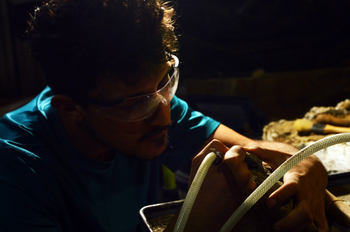
Riccardo Rocchi - Master’s Degree in Biodiversity and Evolution
The Tendaguru Beds Formation (Tanzania) is one of the most significant Upper Jurassic dinosaur fossil sites in the Southern Hemisphere. The University of Tübingen host abundant remains from the Tendaguru Fm, including numerous specimens of Dysalotosaurus lettowvorbecki, a small early-diverging iguanodontian. Although this species is relatively common, complete skeletons are rare. Recently, two semi-articulated juvenile specimens were discovered in the collection of Tübingen, encased in blocks. Since mechanical preparation is not feasible, the research project focused on micro-CT scanning the blocks and segment the CT data, in order to analyze and describe the osteological material and therefore provide a more complete picture of the appearance of Dysalotosaurus. (Co-supervised: F. M. Rotatori; G. S. Ferreira)
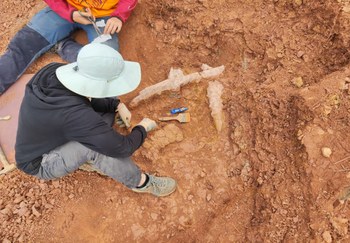
Alessia Buccella - Master’s degree in Biodiversity and evolution
This project’s main goal is to study an enigmatic dentary from the Early Cretaceous sites of the El Castellar Formation in Galve, Teruel Province, North-East Spain. Segmentation techniques from micro-CT scan data will be applied to better characterize the fossil. The morphologic and taxonomic description hope to provide a clearer image of this organism’s identification. In collaboration with the team Aragosaurus: Recursos Geológicos y Paleoambientes. (Co-supervisor: Miguel Moreno-Azanza)
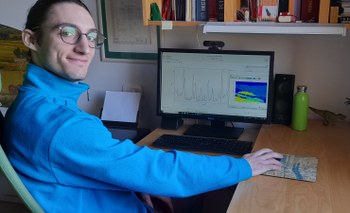
Lorenzo Baldassarri - LM in Biodiversity and Evolution
The project has been developed as a partership between the Dept. BiGeA and the Elettra Sincrotrone (Basovizza, Trieste) and aims to investigate the geochemical signature of both sediments and fossil remains from the Villaggio del Pescatore site (Duino-Aurisina, Trieste). Data will be used to shade new light into the ecosystem in which a diverse vertebrate fauna lived as well as taphonomic factors.
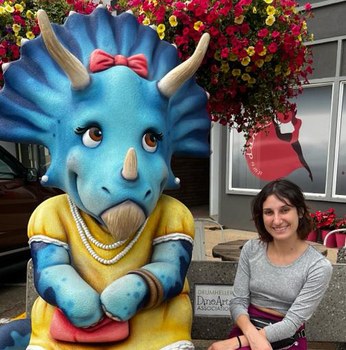
Alessia Furlan - LM in Biodiversity and Evolution
This research project focuses on a rich collection of Pleistocene vertebrate remains from the Ca' Nigra locality (Slovenia), a sinkhole known since the 1900's. Fossil material housed at the Museo Capellini provide important perspectives on the diversity of the site and include diverse marco- and micro-mammals, amphibians, squamates, birds, and fish.
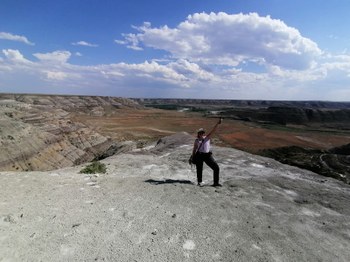
Claudia Salvador - LM in Geology and Land Management
This research project focuses on the stratigraphic successions of the Oldman Formation (Campanian, Cretaceous) which crops out along the Milk River valley in Alberta (Canada) and Montana (United States). In particular, field data are used to study stratigraphy, depositional facies, petrography and sequence stratigraphy in continental environments. The results will be fundamental for understanding the rich vertebrate faunas found in the Oldman Formation.
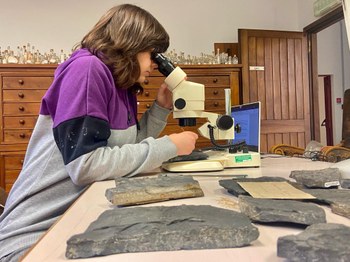
Chiara Magi - LM in Biodiversity and Evolution
This project focuses on fossil vertebrates from the Triassic deposits of Besano - Meride, right at the Italy-Switzerland border, housed at the Museo Capellini. Specimens include fish and marine reptiles such as mixosaurs and thalattosaurs.
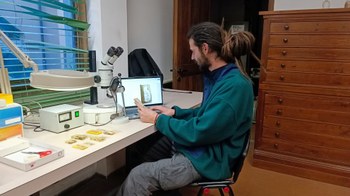
Valerio Patti - LM in Biodiversity and Evolution
Through histological analyses, this project aims to characterize teeth microstructures in crocodiles and theropod dinosaurs from the continental deposits of southern Tunisia dated to the Aptian-Albian (Cretaceous). Differences observed in the samples can provide fundamental tools on how to effectively distinguish taxa represented only by isolated teeth and provide important proxies on the resources and feeding strategies of the different groups represented in the Tunisian fossil record.
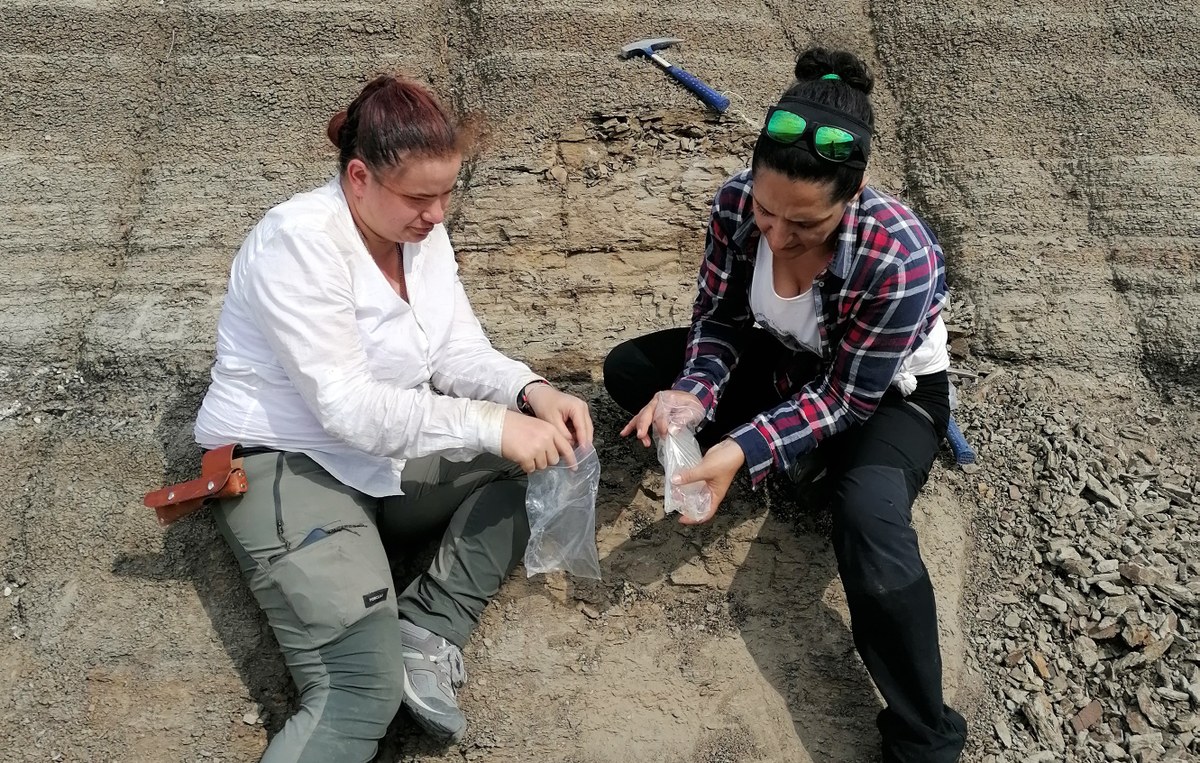
Bachelor's thesis
1. Crescentini L., AA 2012-2013: Neogene proboscideans in the collections of the Museo G. Capellini: a taxonomic revision.
2. Martinelli A., AA 2012-2013: Fossil vertebrates from the Oum Ed Diam Member (Ain El Guettar Formation, Aptian) from the Tataouine basin of southern Tunisia: implication for the identification of isolated teeth.
3. Crescenzi Lanna E., AA 2012-2013: Geological survey and facies analysis of the El Mra locality (southern Tunisia). (co-supervised with L. Cantelli)
4. Angelicola L., AA 2013-2014: Analysis of UV fluorescence emission in Bolca fossil vertebrates:a tool to discriminate preserved soft tissues.
5. Cerisara R., AA 2013-2014: Taphonomy of the Ursus spelaeus - dominated deposits of the Govjestica Cave, Bosnia.
6. Cattarin S., AA 2013-2014: Taxonomy of the fossil beds of the Govjestica Cave, Bosnia.
7. La Rocca Conte G., AA 2014-2015: The fossil shark Alopiopsis cuvieri in the collections of the Museo G. Capellini: taxonomic considerations based on comparative analyses with extant carcharhiniformes.
8. Bidini C., AA 2014-2015: Detailed geological cartography of the Tataouine Basin on GIS platform.
9. Alessandrini G., AA 2014-2015: Allosaurus fragilis in the collections of the Museo di Paleontologia dell'Università di Modena e Reggio-Emilia: analysis and redescription.
10. Rotatori F.M., AA 2015-2016: Taxonomic revision of the ‘Filhol’ mammal collection (Quercy Phosphorites Formation, Paleogene) in the collections of the Museo G. Capellini
11. Mione V., AA 2016-2017: L’uso di tecniche tridimensionali nella museologia scientifica: la ricostruzione del dente del cranio di Narvalo del Museo di Anatomia Comparata dell’Università di Bologna.
12. Sanna G., AA. 2016-2017: La modellazione 3D come strumento didattico, museale e di ricerca: il caso degli "ospiti boreali" del Mediterraneo.
13. Bagli C., AA. 2017-2018: Resti di vertebrati fossili dei depositi fluvio-lacustri pleistocenici del Torrente Conca (RN)
14. Perillo M., AA 2017-2018. Descrizione di un cranio fossile di Lystrosaurus mediante analisi Tomografiche Dual Energy.
15. Casadei F., AA 2018-2019. Micro-tomografia applicata allo studio di reperti fossili e paleoambienti. (supervisor M. P. Morigi, co-supervisor M. Bettuzzi).
16. Prino A., AA 2018/2019 Studio degli osteitti pliocenici di Orciano presenti nel Museo Geologico Giovanni Capellini
17. Perlini E.M., 2018/2019 Studio sui condroitti pliocenici di Orciano presenti al Museo Geologico Giovanni Capellini
18. Paparo M., AA 2019/2020: Descrizione e classificazione di un pesce fossile donato all’università di Bologna appartenente al genere Calamopleurus
19. Muscioni M., AA 2019/2020: Differenze anatomiche nella regione caudale di due esemplari di Tethyshadros insularis e discussione delle implicazioni. (co-supervised with A. Chiarenza)
20. Guasti W., 2019/2020: I resti di Iguanodonte delle collezioni del Museo di Storia Naturale di Firenze (supervisor L. Rook)
21. Florio A., AA 2019/2020, Studio di cranio di iena fossile proveniente dalle grotte di Castellana, Puglia
22. Puccetti N., AA 2019/2020, Resti di serpente dal giacimento fossilifero di Bolca (Eocene) nelle collezioni del Museo Giovanni Capellini.
21. Baldassarri L., AA 2021/2022: Resti fossili (Theropoda e Crocodylia) della Formazione Aïn el Guettar (Cretaceo, Tunisia): istologia dentale e implicazioni paleoecologiche.
22. Gobbo G., AA 2021/2022: La vita di Big John: analisi macro e microscopiche di evidenze traumatiche e predatorie sul cranio di un esemplare di Triceratops horridus
Master's thesis
1. Franchi F., AA 2008-2009: Stratigraphy and facies analysis of the Early Cretaceous deposits of the Tataouine Basin (Southern Tunisia): a discussion on the genesis of multidominant fossil beds. (co-supervised with G.B. Vai)
2. Contessi M., AA 2008-2009: Vertebrate remains from the Barremian-Cenomanian of southern Tunisia: palaeoecological implications (co-supervised with G.B. Vai)
3. Chiarenza A., AA 2013-2014: Morphometric and comparative analysis of the tail of Tataouinea hannibalis (Dinosauria: Sauropoda).
4. Mazzuferi G., AA 2014-2015: Eocene rays from the Pesciara di Bolca: taxonomic revision and comparative analyses with extant taxa.
5. D’Aprile E., AA 2015-2016: Taxonomic revision of the Museo Geologico G. Capellini moa collection using morphometric and philogenetic analyses.
6. Vanni V., AA 2016-2017: The Glyptodont (Xenarthra: Glyptodontia) collection at the Museo Geologico Giovanni Capellini
8. Lustri L., AA. 2016-2017: Descrizione e classificazione di fossili del clade Mesosauridae.
9. Angelicola L., AA. 2016-2017: Ricostruzione cartografica delle località Nemegt e Khulsan (deserto del Gobi, Omnogovi, Mongolia).
10. La Rocca Conte G., AA. 2016.2017: A new specimen of shark from the Monte Postale locality (Eocene, Bolca) and the rise of triakids in ancient ecosystems
11. Milocco K., AA 2020/2021. Studio tafonomico del sito del Villaggio del Pescatore (Duino-Aurisina, Trieste) e revisione di Acynodon adriaticus (Crocodylia). (co-supervisor D. Arbulla)
12. Catellani S., AA 2020/2021. Cartografia e stratigrafia del sito paleontologico di Guriliin Tsaav, Nemegt, Mongolia. (supervisor E. Malinverno; co-supervisor L. Cantelli).
13. Quaranta M., AA 2021/2022: 3D reconstruction of the postcranial skeleton of a new neosuchian crocodylomorph from the Late Jurassic of Portugal (co-supervisor E. Puértolas-Pascual, F.M. Rotatori)
14. Morganico N., AA 2022/2023: Strategie didattiche per l’audience development: la Collezione di Geologia ‘Museo Giovanni Capellini’. (co-supervisor M. Contessi)
15. Della Giustina F., AA 2021/2022. New crocodilian remains from the Late Cretaceous of Catalonia (Spain) expand the postcranial record of a long-extinct clade. (Co-supervisor Dr. Bernat Vila, Istitut Català de Paleontologia).
16. Puccetti N., AA 2022/2023. Analisi petrografica dei depositi della Nemegt Formation (Campaniano-Maastrichtiano, Cretaceo), Mongolia.
17. Rocchi R., AA 2022/2023. Analyses on crocodylian cranial remains from the Late Cretaceous of Southern Pyrenees. (co-supervisor B. Vila Istitut Català de Paleontologia)
18. Muscioni M., AA 2022/2023. Anatomy and paleoecology of Acynodon adriaticus (Eusuchia, Hylaeochampsidae).
19. De Leo N., AA 2022/2023. Morphometric analysis of the Quadrate bone in birds (Theropoda, Aves: Neornithes): insights into diet, foraging mode, and evolutionary history through a digital approach. (co-supervisor prof. Ryan Felice).
PhD
Contessi M.: Palaeontological studies of Cretaceous vertebrate fossil beds in the Tataouine Basin (Southern Tunisia). XXV° cycle, 2010-2013 (co-supervised with M.C. Perri and M. Avanzini)
Cau A.: Integration of Morphologic and Stratigraphic Data in Phylogenetics and Applications in Palaeontology. XXIX° cycle, 2014-2017
Sansonetti M.: Spectroscopy analysis of UV-induced fluorescence for the identification and discrimination of soft tissue in fossil vertebrates. XXIX° cycle, 2014-2017
Zubalich, R.: Palaeogeographic evolution and sequence stratigraphic analysis of the Bearpaw Formation (Upper Cretaceous, central Alberta - Canada). XXXIII° cycle, 2018-2020
Rotatori F.M.: Evolutionary rates of basal iguanodontians around the Jurassic-Cretaceous transition in Europe. Main Advisor, prof. O. Mateus, co-advisor dr. M. Moreno-Azanza, FCT- Universidade NOVA de Lisboa
Muscioni M.:The first Italian dinosaur lagerstätte: a modern paleobiologic approach into the Mesozoic Adriatic Carbonate Platform system’, XXXIX° cycle, STVA University of Bologna - NextGenerationEU Piano Nazionale di Ripresa e Resilienza (PNRR)